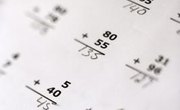Using technology in today's classroom is a given. Far gone are the days when slide-show presentations with attention-grabbing graphics were the classroom's technological zenith. We live in the age where blogs, chat rooms and podcasts are common teaching tools. Yet a classroom can still thrive when stripped down to the basics -- chalk and a chalkboard. Using chalkboards in teaching improves teaching effectiveness, classroom management and student academic success.
Teaching Effectiveness
Teachers have a better chance of reaching students if they have a structured teaching style. Much of a teacher’s style is based on how she presents information to students. Teaching too fast or too slow loses students’ attention. Writing on a chalkboard makes it easier to control the pace of a lecture because it encourages writing while talking -- a task that requires instruction at a moderate speed. According to Barbara Gross Davis’ book, "Tools for Teaching," "students need time to assimilate new information and to take notes, but if you speak too slowly, they may become bored. Try to vary the pace to suit your own style, your message and your audience."
Regulating the pace of a lecture helps control the amount of content students receive. Teaching with chalk allows content to unfold naturally. It eliminates the urge to force-feed information.
Classroom Management
Disruptive students may be less disruptive if they are within a teacher’s visibility. A teacher that has a solid awareness of her students’ actions during classroom instruction has a better chance at maintaining a productive learning environment. Chalkboard instruction assists classroom management because it requires light. Visual aides that require lights off hinder a teacher’s ability to monitor students’ behavior.
Visual reinforcements, like diagrams, can be displayed on a chalkboard to keep students’ attention. Sometimes, students are more willing to engage in a classroom setting if they believe what they are learning has real value. Students that see teachers construct diagrams on a chalkboard witness the process of turning written information into visual information. Teachers should emphasize the importance of this skill and its potential applications.
Student Comprehension
Writing information on a chalkboard helps teachers take visible cues from students. Teachers can immediately address students’ body language and facial expressions that suggest confusion about the material. Teaching with chalk is especially an advantage for teachers of students with mixed learning abilities.
A teacher of students with various learning needs must have flexibility within her teaching style. Necessary adjustments may include not sticking to the lesson plan if students aren’t grasping the material. Content written in chalk can be supplemented with additional information or altered without hassle.
The notes a teacher writes on the chalkboard are essential to a student’s understanding. According to a University of Michigan study on notetaking, student notes are often incomplete and/or inadequate. Providing notes on a chalkboard increases the chances of students taking correct notes. With information clearly in front of them, students take better notes they can later study.
Student Involvement
Getting students to participate makes class more enjoyable for teacher and students alike. Teachers can have students write on the chalkboard to display their understanding of course material. Students may also take turns writing and answering questions, physically identifying areas of confusion or presenting alternative perspectives on the chalkboard that may help their peers.
Related Articles
References
Writer Bio
Ashley Brown began writing in 2005 for “The Albrightian,” the student newspaper of Albright College. The same year, she began working as a writing tutor and editor for the school's writing center. Brown holds a Master of Arts in English from the University of Delaware.










